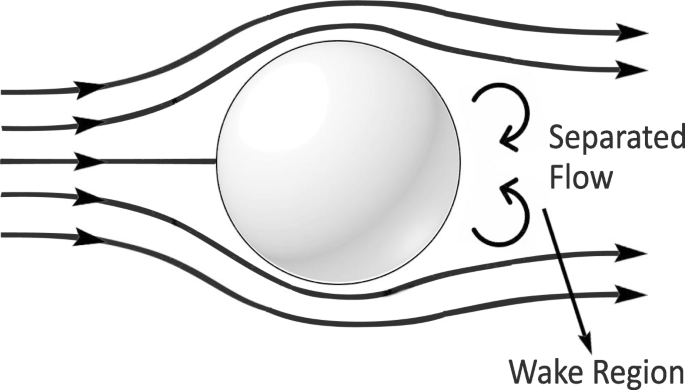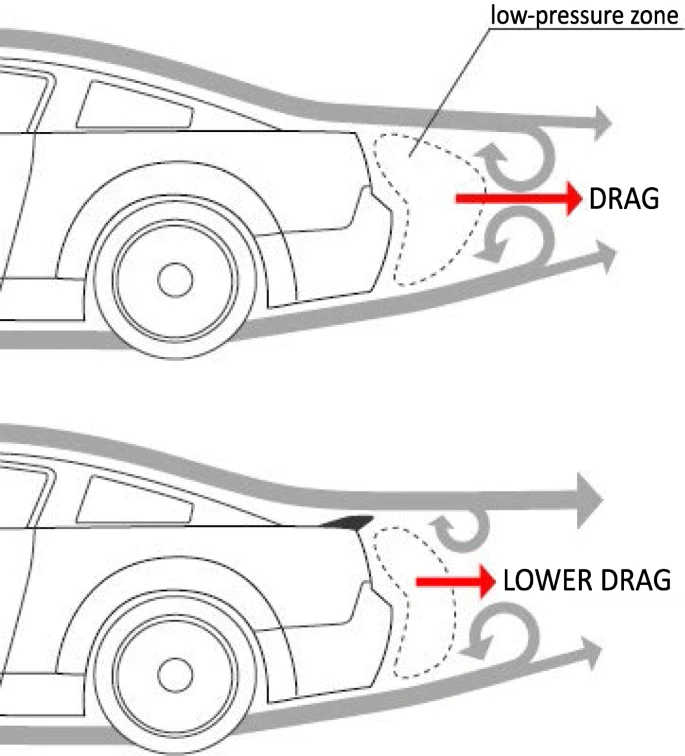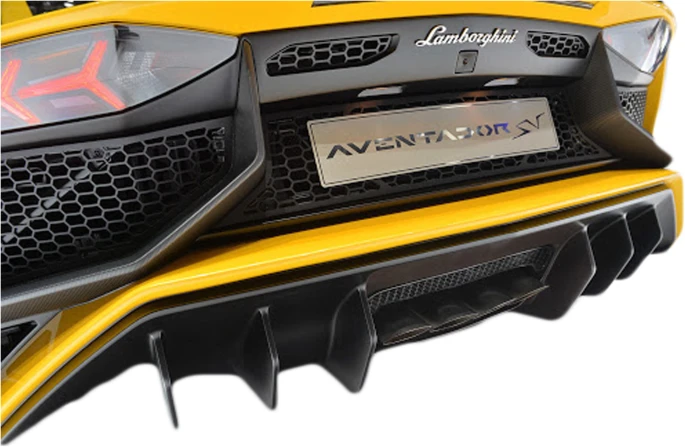Drag & Downforce
Drag
Drag Force predominantly depends upon the velocity, frontal area, and coefficient of drag of the body. It can be expressed as:
(
Where
ρ is the density of fluid medium that is air;
A is the frontal area of the body facing the fluid;
V is the velocity of the body;
Lift
Lift force can be expressed as:
Where
ρ is the density of fluid medium that is air;
A is the frontal area of the body facing the fluid;
V is the velocity of the body;
Flow Separation

- Flow Separation location determines the size of the wake area and the amount of aerodynamic drag is determined accordingly.
- When the air moving over the vehicle is separated at the rear end, it leaves a large low-pressure turbulent region behind the vehicle known as the wake.
- This wake contributes to the formation of pressure drag
- Greater the distance, greater the drag
Aerodynamic Devices
- Various types of aerodynamic devices are designed to modify the lift, downforce and drag induced in cars.
- A few of the passive devices are discussed below
1. Spoiler
- Its main purpose is to “spoil” the unwanted airflow and channel the airflow in order, which helps in reducing the drag.
- However, the actual use of spoiler is noticed at higher speeds approximately above 120 km/h.
- Commercial vehicles usually adopt it to increase the design appeal of the vehicle, which provides little or no aerodynamic advantage.
- Thus, mostly high-performance vehicles adapt it to achieve higher speeds.
- The low-pressure zone behind the vehicle is reduced, thus less turbulence is created, which subsequently leads to drag reduction

2. Wing

- The wing is another essential aerodynamic device often used by race cars. A rear wing may look like a spoiler but is different in its functioning.
- It is shaped like a wing of an airplane turned upside down Click to read more.
- Its main objective is to provide sufficient downforce or negative lift so that the vehicle has increased traction and the vehicle doesn’t lift off at higher speeds [Click to read more](https://aia.springeropen.com/articles/10.1186/s42774-020-00054-7#ref-CR10 "Kajiwara S (2017) Passive variable rear-wing aerodynamics of an open-wheel racing Car. Automot Engine Technol 2(1–4):107–117. )
- It also allows to corner faster and improves stability at high speeds Click to read more
- The angle of the wing (angle of attack) will cause a change in the driving characteristcs of the vehicle Click to red more
- But using a wing may add up the drag to the vehicle body. Thus, for any amount of lift gained, drag also increases Click to read more
- It is generally regarded as a tradeoff between drag and lift
3. Fins

- For the first time in the automotive industry, the application of fins at the rear part of the vehicle’s body is witnessed by Swedish hyper-car manufacturer Koenigsegg Automotive AB.
- Their flagship model “Jesko Absolut” which has the least coefficient of drag in their lineup has fins instead of the wing as shown in
- Fig. 4.
- Fins are inspired by fighter jets to provide high-speed stability and to reduce aerodynamic drag.
4. Diffuser

- The diffuser is one of the prominent aerodynamic devices found in Formula 1 cars. The wide versatility offered by diffusers has found its way down to the high-speed production vehicles.
- Diffusers are capable of reducing drag and increasing downforce for driving cars [Click to read more](https://aia.springeropen.com/articles/10.1186/s42774-020-00054-7#ref-CR13 "Rakibul Hassan SM, Islam T, Ali M, Islam MQ (2014) Numerical study on aerodynamic drag reduction of racing cars. Proc Eng 90:308–313. )
- https://doi.org/10.1016/j.proeng.2014.11.854"),
- [Click to read more](https://aia.springeropen.com/articles/10.1186/s42774-020-00054-7#ref-CR14 "Hu X, Zhang R, Ye J, Xu Y, Zhao Z (2011) Influence of different diffuser angle on Sedan’s aerodynamic characteristics. Phys Procedia 22:239–245. )
- https://doi.org/10.1016/j.phpro.2011.11.038")].
- The role of the diffuser is to expand the flow from underneath the car to the rear, and this in turn produces a pressure potential, which will accelerate the flow underneath the car, resulting in reduced pressure Click to read more
- The principle behind the working of diffusers is based upon Bernoulli’s principle which states that “a slow-moving fluid will exert greater pressure than the fast-moving fluid”.
- Thus, the role of the diffusers is to accelerate the flow of air beneath the car so that less pressure is exerted in comparison to the outer body flow.
- This serves in ejecting out the air from below the car.
- The diffuser then lightens this high-speed air down to normal speed and helps fill the area behind the car, making the entire underbody a more robust downforce and importantly reducing the drag on the vehicle (Fig. 5).
Research Paper
This is a research paper on effects of various Aerodynamic Devices & their effects when used in combination to maximize performance output of Racecar
https://aia.springeropen.com/articles/10.1186/s42774-020-00054-7
Scan QR Code or Click to view the Springer Article on Passive Aerodynamic Devices